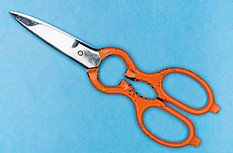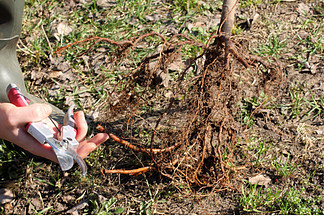While pruning tree roots may sound dreadful, it’s literally usual. If accurately done, tree pruning can boost the plant’s overall health and growth. Shrubs and trees grown outdoors can gain a lot from root pruning, particularly if you are intending to transplant them to a fresh location.
A. Cutting off Container Plants
1. Eliminate the Plant from its Pot
If the pot is too large or hefty for you to hold using one hand, do not hesitate to turn it upside down and strike the pot’s bottom about two or three times. Having done that, the plant should easily be removed from the pot.
- You have the option to hold the pot using your two hands and draw the edge against a sturdy surface or potting bench. You may eventually mess up and may want to seal the ground using a garbage or tarp back upfront
- If you observe that roots are growing through the holes of the drainage, or soil is being drained so quickly, it is a signal that the roots of your container plants need to be cut off and repotted.

2. Prune the Outer Roots and Soil
Prune the external, circular growth of the soil and roots carefully, using a pruning shear or sharpened gardening knife. To have clean cuts, ensure that you sharpen your tool properly.
- Patiently assess the overall health of the roots. Make sure that they have light colors and smell fresh. If the color is dark or the smell is disgusting, it could imply that your plant is infected with fungal disease or has been hit by other serious attacks. Try out a fungicide; restoring your plant could take several months or years.
- Keep at the thin feeder roots that are non-woody. To prevent the plant from dying, do not prune any corm or taproot.
3. Prune up to One-third of the Root Ball as Deemed Fit
After completely loosening the root ball, use the pruning shears and cut off the slim feeder roots from the base. The quantity of roots needed to be pruned is dependent on the plant size and space inside your container.
- Create three or four vertical cuts surrounding the outer part of the remaining root ball, beginning at the base of the root ball and ending about one-third of the way up. This ensures that future circular growth is discouraged.
4. Get Your Plant Repotted at Equal Depth
Once you have cut off the roots, add fresh soil prior to restoring your plant to the container. To have the right proportion of nutrients that the plant needs to grow fresh roots, add fertilizer to it.
- Do not add as many nutrients that you did earlier since fresh roots receive better nutrients than older ones, otherwise you’ll risk feeding your plant beyond normal
- If you see signals of stunted growth or yellow foliage, relocate it from direct sunlight and allow some days for it recovering
- After repotting your plant, water it right away. Track the level of moisture every day, since there’s a possibility of the roots absorbing more water early after being cut off.
B. Pruning Shrub and Tree Roots
1. Obtain a Permit if Needed
If it’s necessary to prune shrub or tree roots on open land, you may have to obtain a local government authority permit. There’s no fixed fee for getting a permit when it comes to pruning roots. To know the right step to take, reach out to your local government authority.
- If the shrub or tree (with its roots) is found on your personal property, you do not essentially need a government permit. If it is near your boundary line, you may first have to address your neighbors about it
- In certain locations, the appropriate local government authority will designate an expert to assess the tree and cut off the roots as it deems necessary. In other locations, you can handle it all alone.
2. Assess the Health Condition of the Tree
If you see that the health condition of a tree is poor, you should not bother pruning its roots. Such trees are possibly stressed due to root pruning and may die eventually.
- Also, consider the conditions of the soil. Pruning roots can result in more havoc if the soil is poorly drained and shallow
- If the roots of a tree are leaning, do not bother pruning such. Doing that could lead to damaging its stability and making it fall.
3. Reach Out to an Industry Arborist
An industry arborist can advise you on how, when, and where to prune the roots of a tree. They can tell you if you can securely do it yourself or not. The opinion of a professional arborist is specifically crucial if you are intending to transfer a tree from one location to another.
- If you are intending to hire an industry expert to do it for you, reach out to two or three companies prior to making an informed decision. Find out about their expertise and contact details. Ensure that they have all updated licenses and insurance or bonding.
4. Decide on the Accurate Size of the Root Ball
If you are aggressive at pruning the roots, you will risk destroying or damaging your shrub or tree. Literally, as the shrub or tree size increases, the root ball size increases accordingly. Different shrub and tree types have their respective least root ball sizes. An ideal root ball size is specifically vital if you intend to transplant the shrub or tree.
- On the official website of the Penn State Agricultural Extension (PSAE), you’ll find a detailed list containing the least root ball diameters of the different types of shrubs and trees available.
5. Put a Mark on the Drip Line
Trees have rooted in feeding as well as for stability. If you observe that the tree has reached its full foliage, mark the line where branches or leaves can drip water onto the soil. The tree’s stability and health require roots growing from this particular line towards the tree’s trunk.
* Literally, stability roots are the roots found within the drip line. The tree will be destabilized if these roots are pruned, making it fall or lean forever.
CONCLUSION
Normally, shrubs and trees grown outdoors can gain a lot from root pruning, especially if you are intending to transplant them to a fresh location. Then, observe that roots are growing through the holes of the drainage, or soil is being drained so quickly, that’s a signal that the roots of your container plants need to be cut off and repotted. Keep in mind, when pruning shrub or tree roots on open land, you may have to obtain a local government authority permit to avoid any delay or issues on it.
I hope you enjoy reading these articles and if you have any questions or something to share about these articles, please leave your comments below and I’ll be happy to get back to you. Thank you so much and enjoy your gardening day.

Jack
Hello there , I really enjoyed reading your article “guide to pruning tree roots”, it’s just what i have been searching for because I have been doing it wrongly for quite some time and this article is such an informative and interesting article, I’ll highly recommend it , after reading this article, I could say I can prune tree roots very well now with no any form of mistake. Thank you for sharing this great article.
admin
Hello Jack,
Thanks for visiting my website and reading my articles about Guide to pruning tree roots. Thank you for your interest in pruning, it helps the plant to grow more nicely and healthy. Learning how to plant properly after pruning is must encouraging. This is done to encourage the growth of new feed roots along with the root ball that will be transplanted along with the tree. Doing all these, also avoiding some of the mistakes.
Thank you and best wishes to you,
Joyce
Syd
This is just what is needed because I have been pruning wrongly for a long time now and I didn’t know that. After reading this and understanding how the shrubs usually have even more defined roots and learning how to cut them from their base, I’m sure that my mistakes will definitely reduce.
admin
Hello Syd,
Thank you for stopping by and reading my articles about guide to pruning tree roots. Thank you that you appreciated it, and apply some guide to your pruning to avoid mistakes next time.
Best regards,
Joyce
Kyle
It is amazing for me to see this, and I must say that I find this awesome to see. I particularly like how you have presented all these here, and it makes total sense for me out here. This is really amazing for me to see, and I have learned a lot from how you have presented all these here. Thumbs up.to you for Shari g here
admin
Thank you so much for your kind comment and your time for stopping by. Best wishes.
Joyce